WASHINGTON, D.C. -- Gallup Daily tracking during January reveals that 61% of the underemployed are not hopeful they will find a job within the next four weeks, while 39% are hopeful.
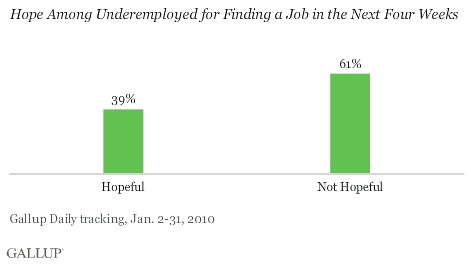
These results are based on interviews with more than 4,000 underemployed U.S. adults, aged 18 and older, during January 2010. Gallup classifies respondents as underemployed if they are either unemployed or work part time but want to work full time. Gallup asks those who are unemployed if they think they will have a job in the next four weeks, and asks those who are employed part time but want to work full time if they think they will have a job in the next four weeks that requires them to work 30 hours or more per week. Respondents who believe they will find work are "hopeful" while those who do not believe they will find work are "not hopeful."
"Nearly two-thirds of those with a college degree or postgraduate education are not hopeful."
A majority of both groups are not hopeful about finding the work they seek, though those currently employed part time are more pessimistic than those who are unemployed. Slightly less than half of the unemployed (45%) believe they will find work within the next four weeks, while only a third of part-timers who want to work full-time (32%) believe they will find full-time employment.
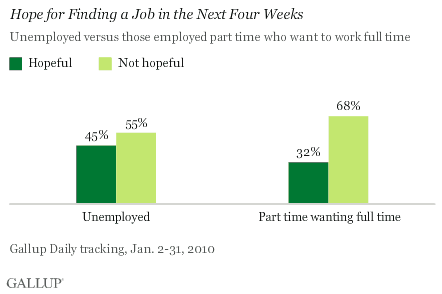
There are several possibilities that might explain the differences in hope between part-timers and the unemployed. By definition, those who are unemployed are searching for jobs, while part-timers may have given up searching for a full-time position, instead having settled for part-time work, even though they indicate that they would like to work full time. Additionally, part-timers' commitments to their current jobs may restrict their ability to search for a better job. Also, part-timers who work for an employer that is reducing hours or laying people off may have little hope for increased hours in the future. Gallup Daily tracking asks employed respondents whether their employers are hiring new people and expanding the size of their workforces, not changing the size of their workforces, or letting people go and reducing the size of their workforces. Part-timers who report their employers are letting people go are less likely to be hopeful (28%) than are those who say their employers are not changing their workforce size (33%) or are hiring (42%).
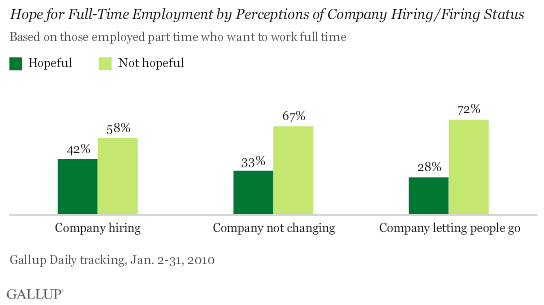
Older Underemployed Are the Least Hopeful
Nearly three-quarters of underemployed Americans aged 50 to 65 (71%) are not hopeful about finding a job within four weeks, making them the demographic group with the lowest likelihood of being hopeful. Still, majorities of all demographic groups of the underemployed are not hopeful about finding the work they seek. On a relative basis, blacks and those aged 18 to 29 are the most likely to be hopeful, at 46%. Men (42%) are slightly more likely than women (37%) to report being hopeful. Hispanics (43%) are more likely than Non-Hispanic whites (37%) to be hopeful.
Nearly two-thirds of those with a college degree or postgraduate education are not hopeful, making them the educational group that is least likely to be hopeful.
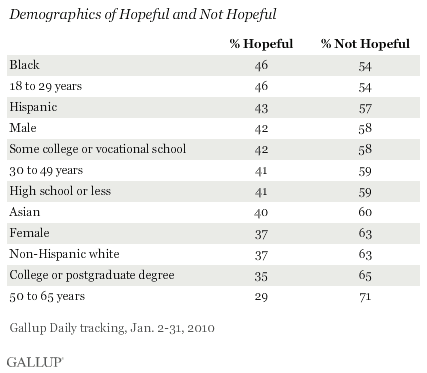
The Financial Cost of Lack of Hope
The underemployed who are hopeful are more likely than the not hopeful to be satisfied with their standard of living (63% vs. 52%, respectively) and to report that their standard of living is getting better (56% vs. 37%), and are almost twice as likely to say they are feeling better about their financial situation these days (45% vs. 23%).
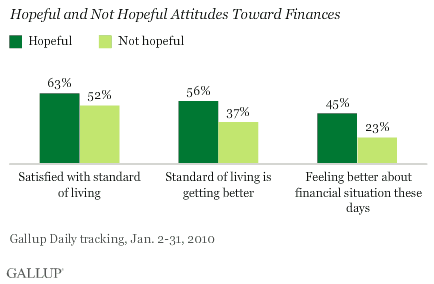
Further, those who are hopeful are less likely than the not hopeful to report that they worried about spending too much money yesterday (19% vs. 33%, respectively). Those who are hopeful are also slightly more likely to say they would be able to make a major purchase "right now" if necessary, although only a minority of both groups report being able to make a purchase (30% vs. 23%).
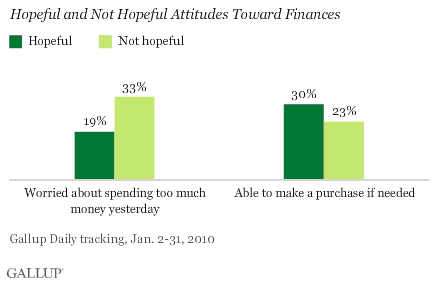
Despite the greater economic optimism among those who are hopeful that they will find employment, those who are hopeful and those who are not hopeful are about equally likely to report that they did not have enough money during the past 12 months to pay for food (37% vs. 35%), shelter (20% vs. 19%), or healthcare (35% vs. 37%), highlighting the daily economic struggles that both groups face.
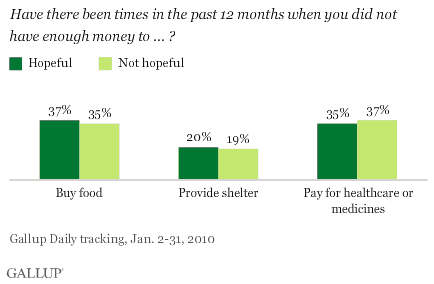
The Impact of Hope on Wellbeing
Individuals who are hopeful about finding work soon are more likely be "thriving" (47%) than are those who are not hopeful (36%). Gallup's definition of "thriving" is based on questions built on the Cantril Self-Anchoring Striving Scale, which asks respondents to evaluate their present and future lives on a ladder scale, with steps numbered from 0 to 10. As a point of reference, 53% of the U.S. population in general was classified as thriving during the same period.
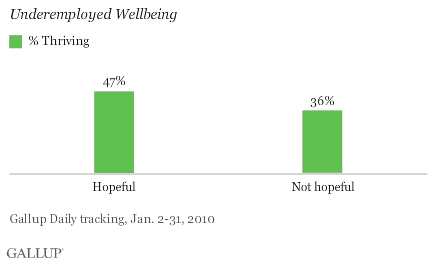
Where the Hopeful Live
Underemployed Americans in the South (42%) and East (40%) are slightly more hopeful they will find a job than are those in the West (38%) and Midwest (36%). This finding parallels Gallup's Job Creation Index, which during January found that job conditions were most favorable in the South and the East.
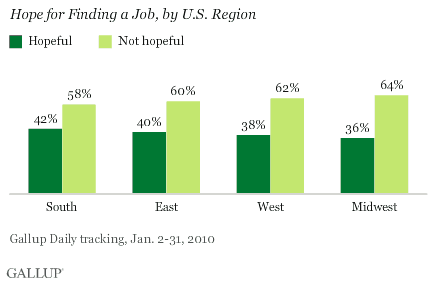
Within local communities, those who are hopeful are more likely to report that their communities are getting better as places to live (63% vs. 48%).
The Politics of the Hopeful
Among the underemployed, those who are hopeful are slightly more likely than the not hopeful to report approving of how President Barack Obama is handling his job (59% vs. 53%). As a point of reference, 49% of the overall U.S. population approved of Obama during the same time frame. Among the hopeful, 20% identify themselves as Republicans, 35% as Democrats, and 34% as independents. Twenty-three percent of the not hopeful identify as Republicans, 34% as Democrats, and 35% as independents.
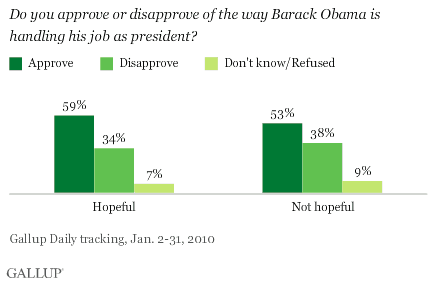
Bottom Line
As unemployment remains high, 61% of underemployed Americans are not hopeful that they will find a job in the next month. Hopeful and not hopeful job seekers differ on several key indicators, such as demographics, finances, and wellbeing. It is possible that individuals who are hopeful about employment are optimistic in general and therefore answer most questions favorably, regardless of external circumstances. However, it is more plausible that hope, or lack thereof, is being driven by current economic conditions. The lack of hope has profound implications, not only for underemployed Americans, but also for the future of the U.S. economy. Gallup will continue to track daily both the employment status of the U.S. workforce and the hope of finding a job among those seeking work, providing a barometer for true recovery as the official recession comes to an end.
Learn more about Gallup's economic measures.
Survey Methods
Results are based on telephone interviews with 4,085 national adults, aged 18 and older, conducted Jan. 2-31, 2010, as part of Gallup Daily tracking. For results based on the total sample of national adults, one can say with 95% confidence that the maximum margin of sampling error is ±2 percentage points.
Interviews are conducted with respondents on land-line telephones (for respondents with a landline telephone) and cellular phones (for respondents who are cell-phone only).
In addition to sampling error, question wording and practical difficulties in conducting surveys can introduce error or bias into the findings of public opinion polls.
